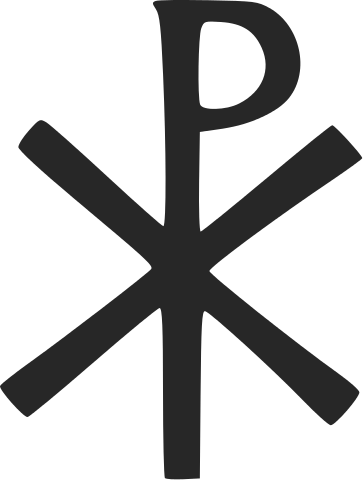Chi-Rho
The Chi Rho is one of the earliest forms of christogram, formed by superimposing the first two (capital) letters—chi and rho (ΧΡ)—of the Greek word ΧΡΙΣΤΟΣ (Christos) in such a way that the vertical stroke of the rho intersects the center of the chi. The Chi-Rho symbol was used by the Roman Emperor Constantine I (r. 306–337 AD) as part of a military standard (vexillum) based on a religious vision he had prior to the Battle of Milvian Bridge in 312 AD.
Origin
According to Lactantius, a Latin historian of North African origins saved from poverty by the Emperor Constantine the Great, who made him tutor to his son Crispus, Constantine had dreamt of being ordered to put a "heavenly divine symbol" (Latin: coeleste signum dei) on the shields of his soldiers. The description of the actual symbol chosen by Emperor Constantine the next morning, as reported by Lactantius, is not very clear: it closely resembles a Tau-Rho or a staurogram, a similar Christian symbol. That very day Constantine's army fought the forces of Maxentius and won the Battle of the Milvian Bridge outside Rome.
Eusebius of Caesarea gave two different accounts of the events. In his church history, written shortly after the battle, when Eusebius hadn't yet had contact with Constantine, he doesn't mention any dream or vision, but compares the defeat of Maxentius (drowned in the Tiber) to that of the biblical pharaoh and credits Constantine's victory to divine protection.
In a memoir of the Roman emperor that Eusebius wrote after Constantine's death (On the Life of Constantine, circa 337–339), a miraculous appearance is said to have come in Gaul long before the Battle of the Milvian Bridge. In this later version, the Roman emperor had been pondering the misfortunes that befell commanders who invoked the help of many different gods, and decided to seek divine aid in the forthcoming battle from Yahweh. At noon, Constantine saw a cross of light imposed over the sun. Attached to it, in Greek characters, was the saying "Τούτῳ Νίκα!" (“In this sign you will conquer!”). Not only Constantine, but the whole army saw the miracle. That night, Christ appeared to the Roman emperor in a dream and told him to make a replica of the sign he had seen in the sky, which would be a sure defence in battle.
Later usage
An early visual representation of the connection between the crucifixion of Jesus and his resurrection, seen in the 4th century sarcophagus of Domitilla in Rome, the use of a wreath around the Chi-Rho symbolizes the victory of the Resurrection over death. After Constantine, the Chi-Rho became part of the official imperial insignia.
Archaeologists have uncovered evidence demonstrating that the Chi-Rho was emblazoned on the helmets of some Late Roman soldiers. Coins and medallions minted during Emperor Constantine's reign also bore the Chi-Rho. By the year 350, the Chi-Rho began to be used on Christian sarcophagi and frescoes. The usurper Magnentius appears to have been the first to use the Chi-Rho monogram flanked by Alpha and Omega, on the reverse of some coins minted in 353. In Roman Britannia, a tessellated mosaic pavement was uncovered at Hinton St. Mary, Dorset, in 1963. On stylistic grounds, it is dated to the 4th century; its central roundel represents a beardless male head and bust draped in a pallium in front of the Chi-Rho symbol, flanked by pomegranates, symbols of eternal life. Another Romano-British Chi-Rho, in fresco, was found at the site of a villa at Lullingstone (illustrated). The symbol was also found on Late Roman Christian signet rings in Britain.
In 2020, archaeologists discovered in Vindolanda in northern England a 5th-century chalice covered in religious iconography, including the Chi-Rho.
